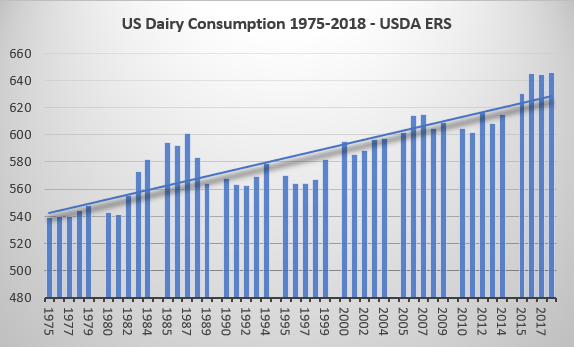FOR IMMEDIATE RELEASE
Contact:
Matt Herrick, IDFA
mherrick@idfa.org
202-220-3537
WASHINGTON, Sept. 5, 2019—A new Morning Consult national tracking poll of 2,200 Americans points to a number of revealing consumer preferences for milk and related beverages. When given the option to choose among whole, reduced fat 2%, low fat 1%, skim, other (almond, soy, oat, other plant-based, lactose-free), or “do not consume” milk, respondents overwhelmingly chose 2% and whole milks because they believe they are most nutritious for themselves and their families. Further, 86% of U.S. adults prefer dairy milk over “other” beverages, including plant-based beverages. Additionally, by a margin of more than 2-1, U.S. adults say it’s important to offer low-fat flavored milks with school meals; and by a 3-1 margin, U.S. adults say it’s important to offer 2% and whole milk with school meals. The poll was conducted by Morning Consult in partnership with the International Dairy Foods Association (IDFA).
Poll Results
The full survey results may be found here. Here are 8 key findings:
- A whopping 67% of adults across key demographics believe 2% and whole milk are the most nutritious types of milk. Thirty-six percent of adults believe 2% milk is the most nutritious, while 31% believe whole milk is the most nutritious.
- At least 86% of adults prefer dairy milk compared to 10% who prefer “other” including plant-based beverages and lactose-free milk.
- Strong opinions about offering flavored milk in schools vastly outweigh strong opinions against. Half of the adults believe it is important that the public school their child attends offers low-fat flavored milk with school meals, while just 22% believe it is unimportant. Twenty-nine percent have no opinion.
- Adults feel similarly about fuller-fat milk with school meals—by a 3-1 margin, U.S. adults say it’s important to offer 2% and whole milk with school meals: 53% believe it is important that milks like 2% and whole are offered in schools, while just 18% feel it is unimportant. Currently, only low fat 1% and skim milks are allowed in schools.
- Overall, more women than men believe it is more important that their children have access to fuller-fat and flavored milks in school.
- Forty-two percent of SNAP participants prefer whole milk for themselves or their families. SNAP participants also report that they believe whole milk is the most nutritious (46%), the only demographic to do so. Of the 2,200 respondents, 336 self-identified as SNAP participants.
- Respondents with incomes under $50,000 (inclusive of 336 SNAP and 115 WIC participants, respectively, who self-identified) believe more strongly than those with higher incomes (above $50,000) that fuller-fat milks are most nutritious and prefer offering these options as well as low-fat flavored milks in schools for their children.
- Variety is key: More than three-quarters (77%) of adults found it important to have a variety of options to choose from when purchasing types of milk.
IDFA Statement on Results
“As the U.S. school year gets underway and millions of American families get back to the routine of juggling the work-school-life balance, maintaining proper nutrition for themselves and their families is top of mind,” said Michael Dykes, D.V.M., president and CEO of IDFA. “Therefore, it is important that policymakers and regulators who influence what we eat stay grounded in the reality of what American families prefer and value. Clearly some policy decisions and discussions—especially those regarding school meals and nutrition programs—are completely out of step with consumer preference and habits, as well as sound dietary guidance. Families recognize that milk provides numerous health benefits, including better bone health, helps to lower the risk of type 2 diabetes and cardiovascular disease, and is the leading food source of calcium, vitamin D, and potassium in the diet of American children. The public’s opinion is clear. Will our policymakers now listen?”
IDFA members are responsible for 90 percent of the milk, cheese, ice cream, yogurt and cultured products, and dairy ingredients produced in the United States and sold throughout the world. IDFA members produce traditional dairy as well as dairy alternative products.
Dairy Consumption Continues to Grow in United States
Data from the Economic Research Service at the U.S. Department of Agriculture (USDA) confirms that U.S. dairy consumption continues to grow, as seen in Figure 1 below. The results from the Morning Consult poll help to underscore a reality that often goes unreported or is misreported—dairy consumption inclusive of milk is growing in the United States.

Nutritional Recommendations and Research on Dairy Consumption
According to the U.S. Departments of Agriculture and Health and Human Services, American children and adolescents over four years old are not consuming enough dairy to meet the Dietary Guidelines for Americans recommendations. As the American Academy of Pediatrics states, “Dairy products play an important role in the diet of children. … In fact, milk is the leading food source of three of the four nutrients of public health concern (calcium, vitamin D, and potassium) in the diet of American children 2-18 years.” Moreover, for individuals who require reduced lactose or lactose-free dairy products, these are widely available.
A growing body of data and research supports dairy’s healthfulness. Of note, a recent recommendation by Australia’s Heart Foundation that healthy Australians can include full-fat milk, cheese and yogurt without increasing their risk of heart disease or stroke is important, official nutritional guidance related to dairy. A study released last summer in The American Journal of Clinical Nutrition came to similar conclusion about the fats in dairy products such as whole milk. As the researcher in that study told The Atlantic magazine: “I think the big news here is that even though there is this conventional wisdom that whole-fat dairy is bad for heart disease, we didn’t find that,” said Marcia de Oliveira Otto, assistant professor of epidemiology, human genetics and environmental science at the University of Texas School of Public Health. “And it’s not only us. A number of recent studies have found the same thing.” This study published in Lancet in 2018 is another example.
Details on Morning Consult Poll
This poll was conducted by Morning Consult, a national survey firm that also publishes analysis of polling and survey data on public policy issues. This poll was conducted from August 16-18, 2019. The interviews were conducted online and the data were weighted to approximate a target sample of adults based on age, educational attainment, gender, race, and region. Results from the full survey have a margin of error of plus or minus 2 percentage points.

